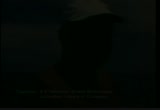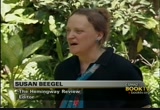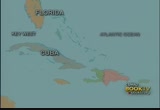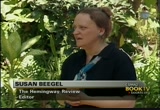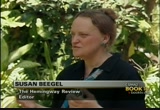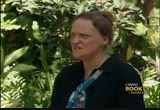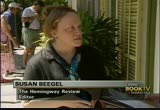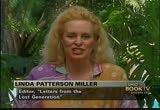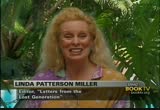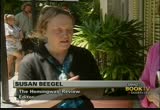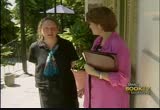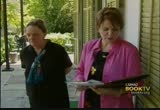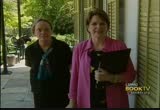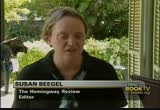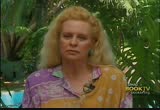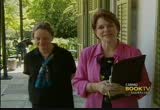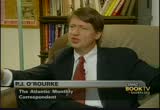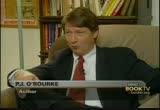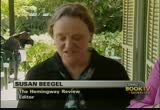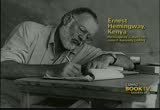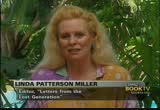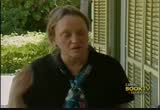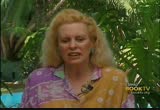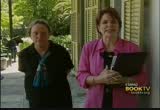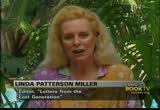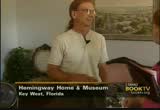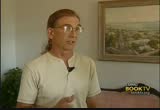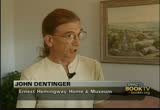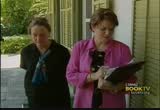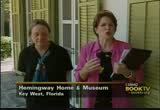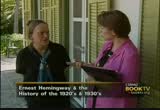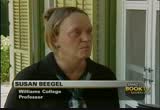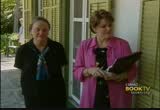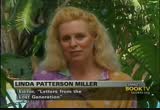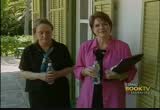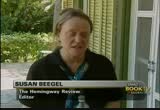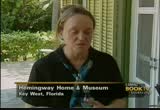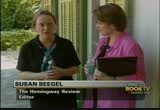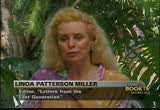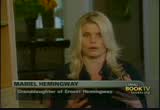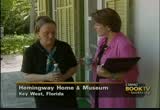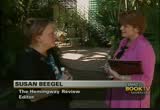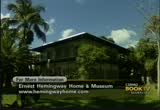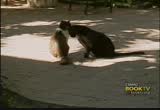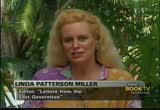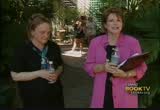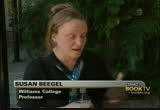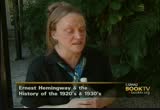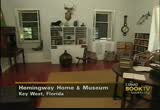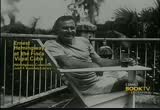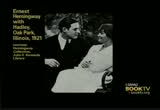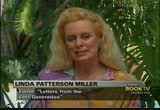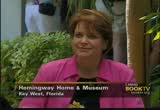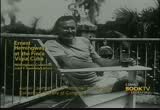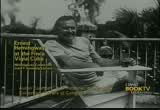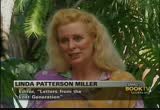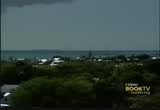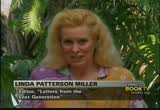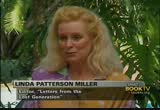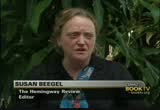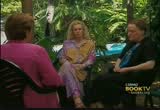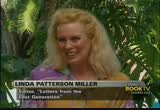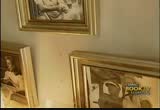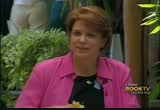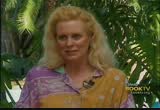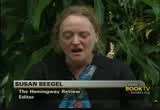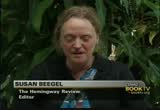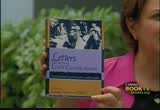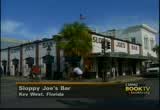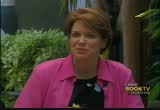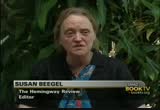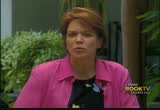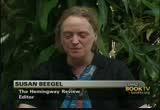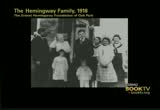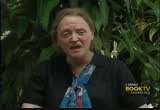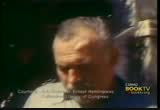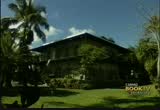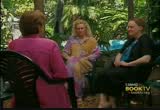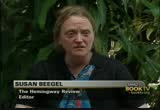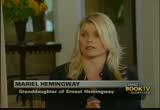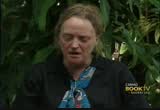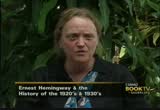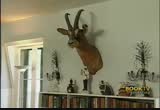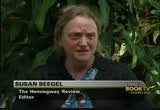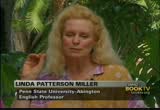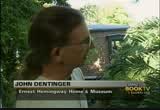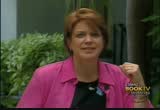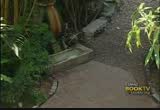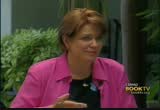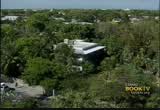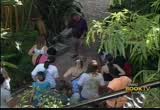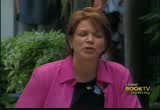tv Book TV CSPAN July 3, 2011 2:00am-4:00am EDT
2:00 am
now. ♪ >> that's some rare footage of ernest hemmingway off the coast of key west, florida. key west is where c-span is today as our "american writers ii" series continues its journey through american history. today, we will focus particularly on the 1920's and 1930's through the life and times of this nobel prize-winning writer with 21 books to his credit. joining me live from the ernest hemmingway home in key west is susan beigl. >> i think in a lot of ways, ernest hemmingway almost is the first half of the american 20th century.
2:01 am
he's born in 1899, just as the new century's about to begin, and he's of age to come under fire in world war i, to experience the growth of american literary modernism in paris, he goes to the spanish civil war, he's back under fire in world war ii and as well as being a wonderful writer of fiction, he's also a journalist. he's travelling the globe to the greco-turkish war, he's a citizen of the world. >> how did he get here to key west? >> he arrived he ever in the year 1928. he was returning from paris with his second wife, pauline pfeiffer. she was pregnant with their first child, seven months pregnant. their idea was to, tha they acty took an ocean liner to cuba, took a ferry from cuba to key west. they were going to pick up a car here. pauline pfeiffer's rich uncle was giving them a car to drive
2:02 am
to her family home in arkansas. the car wasn't ready when they got here, so the ford dealership gave them a little apartment and they spent six weeks here waiting for that car. during that time, hemmingway fell in love with the place. he met local people who took him out fishing. one of my friends likes to say probably the first time he got a 30-pound tarpin on a two-pound line he was hooked on key west. after that visit, they kept returning for the next two years. in 1931, they bought their home here. >> if you haven't been to key west, let's give you a little sense of place so you know where we are. if you were to land at the miami airport and drive about three and a half to four hours depending on the traffic, this is truly an island with a seve seven-mile bridge to cross into it. it is the southern most point in the united states. we are about 90 miles away from cuba, which was an important part of his life. >> i think hemmingway's great love in this area is actually
2:03 am
the gulf stream which kind of forms a wall between key west and cuba. what really, really hooked him into this place was fishing in the gulf stream and then watching the trade of these two cultures across the stream. when he got here, it was still prohibition. the principle source of the economy in this community was smuggling liquor across the stream into cuba. the 1930's, we had drastic immigration laws and restrictions in effect, so smuggling aliens across the gulf stream from cuba into key west was also a big part of the scene then. cuba itself was locked in revolution. there was a rit-wing military dictator in power. there was a growing communist revolt against him, so a lot of revolutionary activity, gun-running, very exciting time to be here in key west. so, he loved the fishing, he loved hispanic culture, he loved the real people here and kind of hard-boiled life that they led.
2:04 am
dealing with these two cultures and the transitional period. >> in each one of these programs, we are focusing in on a particular work of the writer. in this one, we are dealing with ernest hemmingway's classic book "the sun also rises" and the modern library list of books at the end of the 20th century, this was number 45 of the most influential novels of the century. for him, which book was it? >> for hemmingway, it was his first novel. his very first book was a collection of short stories called "in our time" which absolutely was a ground-breaking book. one of the things we all need to remember about hemmingway is that in a sense he created american literary modernism and brought it into the main stream. that very simple, streamlined clear prose that completely overturned all the ornate victorianism of the 19th century was created first in the book of short stories "in our times" and with the novel, whic which is wt brought him on the scene as a major writer, very famous for its conversation, its dialogue,
2:05 am
its introduction of lost generation characters. >> it was published in 1926 by whom? >> by charles scribner's. fitzgerald introduced him to maxwell perkin s. a great start to his career to be with scribners. >> we are just outside hemmingway's home. we are right by route 1 and i want to tell those of you who have not been here, all the millions of us who live in east coast america are als also very familiar with u.s. route 1 running from maine to florida. its terminus point is about a block away. this is as far as you can go and still be in the united states of america. this is a city with about 33,000 permanent residents and lots of tourists. we are at the height of the tourist season. this place is open for business today, so you will see lots of the people who are here visiting
2:06 am
ernest hemmingway's house as we are talking about it. what's important about this program is your participation. in a few minutes we will begin taking your telephone calls. we are going to be talking about his writing, but the writing is in the larg larger context of wt was happening in the country of the 1920's and 1930's. if you would like to join us, please do. >> in 1926 in america when his book came out, tell me about the country. who was reading him? >> the people who were really enjoying hemmingway were really people of his own age group, to a certain extent. >> which would have been how old? >> they would be people in their late 20's. the flappers, the young people of that era who had served in world war i and became very
2:07 am
disillusioned with the older generation and its values. it was a terribly alienating war. milosevic of people dead. the first major conflict in world history. very turned off from the values of their parents, the whole make money business culture. a comparable thing i think would be the 1960's generation during the vietnam war. >> really created lost generation style, a sense of speech, a sense of dress. he was immediately embraced by the literary community. people were actually collecting his manuscripts in paris before he was ever published in the united states knowing he was going to be a sensation. >> you and i are going to take a little walk and we will make our way around some of the grounds of the house here and while we are doing that, tell me more about his world war i experience. >> he went to world war i as an ambulance driver with the american red cross. >> why didn't he serve? >> he wasn't able to serve.
2:08 am
he had very bad eyesight. couldn't get into the u.s. army and was an ambulance corpsman and badly wounded in italy. he was the first american wounded in italy, in a trench when it was hit by a mortar. called them a trash can mortal filled with nails and pieces of metallic garbage. he received over 227 little pieces of shrapnal in his legs. got out of the trench in spite of that to carry a wounded man back from the lines. when he got out, was hit twice by machine gun fire. got a bullet in the knee and foot. spent a long time recuperating in the hospital in milan. and read farewell to arms, a wonderful story about a wounded ambulance man and a nurse, he met and fell in love with a nurse when he was there. >> when he finished his war-time recoupation, did he come back to the states? >> he came back to the united states briefly to continue a career as a journalist.
2:09 am
that he had begun before he left. he was a reporter as a young man for the "kansas city star" and the "toronto star" but he didn't stay here long. he got introductions to some of the great writers in paris, ezra pound and he wanted to go over there. so he married elizabeth hadley richardson, had a little trust fund and off they went to europe to see if he could become a writer. >> >> : as you and i are standing on the corner of this ernest hemmingway home here where it is about 85 degrees and we have this balmy assignment this afternoon in the tropics. i want to introduce you to another guest who will be with us throughout the program and she is an expert on the lost generation. linda miller is joining us. she's at a set just around the corner from us here under the palm trees and linda miller sh at this point, would you just pick up, please, and explain a little bit more about the group called "the lost generation"? >> the lost generation was probably an expression coined by gertrude stein.
2:10 am
she told hemmingway during one of his visits to her and her salon in paris, that hemmingway and his generation were a lost generation. hemmingway asked her well what do you mean by that? and she said "you drink too much." hemmingway took umbrage with her definition of them as a lost generation and decided that actually probably every generation was lost in one way or another. but it is an expression ca captioned for this group of writers and artists that has stuck. hemmingway's friend, archbold mcleish said it was not an apt coinage for their group, because he said it wasn't themselves who were lost, but it was the world out of which they had come that was lost to them. and so i think to talk about their lostness, what these writers were doing and much of it was when they left america to find america in europe, to find america, as john peale bishop, a
2:11 am
friend of hemmingway's and this group said was to find america in one's heart, in one's spirit, and in a foreign land. there was something about this idea of transplanting yourself in another location away from america so as to write about america and discover the american identity. >> let's get our first telephone call in from san diego. you are on c-span. please go ahead. >> caller: hello and thank you for taking my call. i have been anxiously waiting for this particular program because i am a big fan of ernest hemmingway. several years ago back in the 1960's, a friend from the university of indiana sent me a copy of what was called "a man's credo" by ernest hemmingway. i have never seen it published or heard about it from any source that i have accessed and i was wondering if any viewer or your guests might have come across this? one of the quotes from the credo states a long life oftentimes
2:12 am
keeps man from his oh optimism. i thought this was insightful given the fact that hemmingway did commit suicide. i will wait for your response. thank you. >> thanks very much. susan beegle is editor, i should tell you she teaches, but she's also the editor of the hemmingway review published out of the university of idaho, spent a lot of time with his writing. have you ever heard of "a man's credo"? >> i have never heard that and i don't believe he ever wrote anything specifically titled that. i would guess it might be a work where an editor has perhaps if i d up quotations from hemmingway and made "a man's credo" out of them. haven't heard that specific quotation, either. but he did write in something called "the art of the short story" that the writers of short stories come to no good end and writing about, including fiction, but also writing about suicide, he said long evident is
2:13 am
not an end, it is a prolongati prolongation. shuck it off. >> arlington, virginia, you are on c-span. welcome to our discussion about ernest hemmingway. >> caller: thank you. good afternoon. i am interested to know if your experts have any knowledge or input of a jewel that ernest hemmingway was supposedly involved with? i believe a reporter from new zealand? his name may have been thomas scott or edward scott and i just have heard rumors that he was, there was a challenge to a dual. and i just wondered if there was any truth to it or if they could elap rate on that. >> linda miller, do you know about a dual in his past? >> i know about a dual that he had in the office of max perkins related to a challenge to hemmingway's masculinity. but i don't know of any dual related to this at all. that's new. i had not heard of "the credo"
2:14 am
either that was brought up in the previous quee sue susan bee, just given our first two questions, you begin to see that this man live ad larger-than-life kind of existence. how typical would he have been of men of his generation? >> well, you know, these questions are very much related to the hemmingway reputation. he has a mythic persona. people love t to invent and tell story bs him and these are both very exemplary. one having to do with what manhood means and one having to do with combativeness. >> a lot of that kind of thing actually began right here in key west. during the 1930's for the first time, he began writing for a new magazine called "esquire." he was writing monthly articles for them about deep sea fishing, about experiences in africa, big game hunting and writing for an audience that was growing and growing with this i very successful magazine, until by
2:15 am
the end of the 1930's, he was appearing in a magazine that had a readership of about a million men. so this was a period that helped to create that persona, that masculine persona where he was writing as himself for men about his adventures. that, i think, contributes to these stories that are out there. >> before our next call, we would like to let yo you listeno his voice. this is a little clip of him talking about the many places where he's written in his career. let's listen. >> beside the fifth column, i wrote "the killers". "today is friday." "ten indians," part of "the sun also rises" and the first third of "to have and have not" in madrid. it was always a good place for working. so was paris and so were key west, florida an in the cool months. the ranch near cook city,
2:16 am
montana, kansas city, chicago, toronto and havana, cuba. the first one i wrote was up in michigan, written in paris in 1921. the last was "old man at the bridge," cabled from barcelona in april of 1938. >> that was ernest hemmingway in his own voice. here we have a man in the 1920's and 1930's and beyond really experiencing much of the world. how much does it make it into his writing? did his readers learn about the larger world when they read his work? >> it's absolutely everywhere. in "the sun also rises," it's set in paris and at the bullfights in spain. "farewell to arms" in italy. "to have and have not" is cuba. journalism from all over the world. i think it's a real lesson for
2:17 am
us today. americans tend to be very insular, very cut-off people and maybe's hemmingway's choosing that line from john dunn from for whom the bell tolls, says it all. whereever there was strife or war going on, a revolution, he was interested. he thought we should be there and he thought it was the job of a writer to bear witness to th that. and he also took his readers along on some wonderful adventures. not just the war, but big game hunting in africa, bullfighting in spain, deep sea fishing. lots of excitement in his work. >> next phone call is from connecticut. >> caller: yes, i have a letter that was sent to hemmingway in 1934 by the editor of malcolm cowley of the new republic. i was wondering what kind of a relationship they had? >> they had a really interesting
2:18 am
relationship and that letter could be a real treasure. malcolm calley was one of the most important critics of the lost generation. he helped to make the critical reputation of hemmingway and fitzgerald. they had a long correspondence together. discussion about hemmingway's work and what it meant. hemmingway very interested in his opinion about what made writers marketable, what helped to contribute to their reputation. so you are a lucky guy. >> why don't you and i continue our journey, the farther we can get away from this street, think the better off we are here. plus, i see a little bit of shade as we are working our way down here. talk to me a bit about how he first got started writing. was there a writer in his fami family? >> there was no writer in hemmingway's family, but his mother was a singer and a composer of music and later a painter and someone who just deeply valued the arts and tried to cultivate them in all of her
2:19 am
children. he had a fantastic high school education at oak park high school. wonderful teachers of english who encouraged him, not only studied literature, he also studied english. he knew when he graduated he wanted to write. he immediately took a job as a reporter with the "kansas city star" rather than going to college. he wanted a job to take him to exciting places that he could write about. we know that from the time he was in world war i and he was 19 years old, wounded in this hospital bed, he's writing short stories on red cross hospital stationery. when he gets back from the war, he's very serious about having a career as a writer. it's often true that people touched by genius, they just know and start young pursuing that. >> linda miller, i don't know if you are comfortable doing this, but when you talked about the writers of the lost generation, you named some of the phag major figures.
2:20 am
ezra pound, e.e. comings. if you were to judge hemmingway's influence in that larger group, where would you stack him up? >> well, quite honestly, i would put him first. i think once he went over to paris and began to see the experimentation going on in the arts, particularly in painting, and decided that he wanted to write the way the painters painted, i think as susan said earlier, hemmingway was radical in bringing to america and american art a modernism and a modernism that didn't just have to do with painting, but it had to do with all of the arts and the way that hemmingway defined, literally, a new style of writing for the 20th century. every writer you talk to today usually has to acknowledge that he or she has to deal with hemmingway somehow because he radically revised the way sentences were structured and the way a piece of literary art became almost like a literary
2:21 am
canvas. at the same time, he had determined that the writer should not describe, but the writer should make. and it was a question for him of how to bring that art. the immiadcy of the moment to life. i think he was at the top. at first when he went over there, he was new and untutored and scott fitzgerald was better known having published "the great gatsby." there was press that took over after they met in the bar in paris and they talked together and became very close friends and influenced each other's art very much. hemmingway became more on the ascendency. >> philadelphia a you are next.
2:22 am
go ahead, please. >> caller: hello? hello? >> sir, ask your question. we can hear you. >> caller: ok, great. i wanted to ask the question, i had read the story at one time about hemmingway having actually met, i guess, what was his second wife, i think her name was martha gelhorn, in a bar in key west and i just wondered if the ladies there could explain that and how that all transpir transpired. >> thanks very much. susan beegle, how many wives were there? >> martha gelhorn was actually hemmingway's third wife. >> three of? >> three out of four. >> four wifies altogether. >> he did meet march that here in a bar in key west. she was a wonderful writer about the depression era and its problems. she was dow down here as an investigator reporting a story on the federal emergency relief agency and what they were doing in the town of key west. so they did meet here. they didn't, however, start having an affair until they both
2:23 am
went off to report on the spanish civil war in about 1938 and then they were actually living together in a hotel in madrid under shell fire while the second wife, pauline pfeiffer, and his two sons with pauline were back home here. >> how many children? >> three altogether. one with his first wife, elizabeth hadley richardson, and two boy was pauline pfeiffer. >> next call is newtown square, pennsylvania. go ahead. caller, you are on c-span. go ahead. >> caller: hello. >> pennsylvania, please speak up. we can hear you. >> yes, this is for dr. miller, actually, linda miller. i happen to have a copy of her book "the letters from the lost generation" and it's actual lay wonderful book and chro chronics beautifully the life among all the artists at that time. particularly, i would like to get her feel on the relationship between hemmingway and fit
2:24 am
fitzgerald when they were in paris. i also enjoyed "a moveable feast" which documented that time, as well. >> thanks, linda miller, as you answer, i am going to ask you, i know you spent a lot of time on this relationship, but not just the personal one, put it in the larger context of history and the society at the time, please. >> well, i think it was a very close relationship during the time that they knew each other in paris and it was a relationship that continued throughout fitzgerald's life. he died in 1940 and it was very important to fitzgerald's art, think, he always felt that momentumomentum was a model ford there was a little bit of competition between of the two of them. i think it probably assumes more importance for fitzgerald than it did for hemmingway. >> next phone call is from los angeles. hello, los angeles, what's your question for us? los angeles, are you there?
2:25 am
all right, let's move from los angeles. we have been hearing two people who have spent their life studying hemmingway's work and not surprisingly, have lots to say about him that's complimen complimentary. you don't always find that. i wanted you to hear p.j. orourke talking about his view of hemmingway's writing. >> the books go from bad, man catches fish, catches fish, catches fish, fish gets et, deep truth, to things like to have and have not which starts out as a portrait of 1930's havana and winds up just about as stinky as you could possibly imagine a novel winding up. hemmingway had no sense of humor whatsoever. and i mean that in the classic sense, sense of humor.
2:26 am
he had no distance on things. he could not stand back and look at things esm was always telling you that something was important. that it was true. that it was fine. that it was this or that and the other thing. well, ernie, show, we don't tell. we show. his writing on bullfighting is particularly offensive in this respect. his women characters are hopeless. they really don't exist at all. and "the sun also rises," my least favorite hemmingway book, is really my least favorite, well, it's a tough call, but i would say it's my least favorite because you think this book is about a generation destroyed by world war i, about cynicism, about the breakdown in western culture, but if you read it more carefully, you realize what it's about is drinking too much. they drink too much. of course drin he is impotent.
2:27 am
he didn't get hit in the war. you cannot drink that much and be anything other than impotent. >> i am sure you both want to have at him with that. >> well, you know, it's difficult for me to think of two people whose politics are different than p.j. who is kind of right-wing republican and hemmingway, who is really -- i can see maybe the lack of sympathy for "to have and have not." absolutely not true that he had no sense of humor. "the sun also rises" in particular is a deeply funny book. some of the journalism is very funny. in a very raunchy, bawdy fashion, a little bit of 1930's south park version. hemmingway also poking fun at political correctness, at the wealthy, at the kind of, actually, class that we often see p.j. ow orourke representin,
2:28 am
the business-suited ones. i wouldn't go along with that evaluation. it's easy to belittle things. "man catches fish," well that's the plot of moby dick, as well. you have to be more sympathetic to the author's project than that. >> linda miller? >> well, there are several things i could respond to, but i will pick a couple of plithy points. i think we have to remember that hemmingway was an experimenter. people want to box him into a hemmingway style. what is that style? he tried a lot of different things throughout his career and people didn't always warm to what he did because they were expecting something else. the second point, about his female characters, that's a stereotype and i might question him how much he's really read of hemmingway. people tend to read the stereotype of hemmingway as this womanizer. but actually, his female characters in many of his works, and particularly his early short stories, marvelous characters
2:29 am
and complicated. >> let me interrupt you, because again, trying to learn more about society at the time, how were his depiction of females in his book compared to women liveingin america at the time? >> i think if you look at "the sun also rises," it's a good example, even though brett ashley is over there in paris and spain in the 1920's, she embodies the american woman. after all remember by 1920, women had earned the right to vote and there was a supposed loosening up of a world for a more liberated world for women. but you see women like brett ashley who really is very much trap bid her female identity, the men dance around her as an image to dance around and she's not really allowed to be herself and doesn't know how to be herself and doesn't know how to find that self within a world that still is not giving her many options. so, a character like that shows, i think, still the limitations for women in the 20th century and it's too easy to say that
2:30 am
they were now liberated women. >> newark, ohio, you are on as we talk about ernest hemmingway. welcome. >> caller: thank you. i would like to compliment both of your guests on the response to mr. orourke and along the women's line, what do you think the influence was that his mother had on him? >> thanks very much. susan beegle? eye think hemmingway's mother had a profound influence on him and we will hear a little more about this in upcoming scholarship, but i think as i mentioned before, grace was a composer, a very fine musician, studied as an opera singer. she trained all of her children in music and particularly trained him to play the cello, got him interested in classical music and i think she was one of really his first great m mentor. his style involves brilliant use of repetition and very musical use of repetition, probably is as much connected to his mother's early training in music as it is to working with people, for instance, like stein and ezra pound in paris. she also told her kids about the
2:31 am
arts that, if you don't tell me you love to write, don't tell me you love to play the cello. work is love. and if you love it, you will do it. and she, herself, was a very disciplined artist, put her art before her family, which was sometimes difficult in the home, but she taught him to do that, too. to be a professional. >> next telephone call is from berckley, california on ernest hemmingway. please go ahead. >> caller: hi, there. i've just started reading hemmingway at my community college and i have been enjoying some of his works. we are working with snows of kilimanjaro right now and i am writing a short analytical essay about that story. it's going pretty well but i do have one question for you. that's: what is hemmingway trying to say about death at the end of that story? has the character harry grown or changed anyway by his experience of a slow and timely death? >> linda miller, will you take
2:32 am
that? >> in that story, you have the portrait of an artist who is looking back at his own life and feels that he has betrayed his art. here is he dying and he hasn't been able to write about all the things that have really mattered in his life and all the thinks that he wanted to write about. so in that story, you have what one hemmingway scholar said, you have a writer who is packing in there all kinds of things that each in and of itself could have been a wonderful story. by the end of the story, he does die and then you get this kind of transendent scene at the end but he is rising above to the mountain of kilimanjaro. in the end, it's a rather transendent story. it's not so much about the nature of dying, but the nature of what it means to be an artist where the most important thing to you is to write and if you can't write, you might as well not live. >> danville, kentucky, as we
2:33 am
talk about ernest hemmingway, what happens on your mind? >> caller: i wanted to ask about the lost generation. i was reading something that gertrude, i think she wrote, but anyway, she said she picked that up from the mechanic who took care of her model t ford and i was wondering if anyone might comment on that. it wasn't an original with her. >> linda miller? >> yes. that was the passage, the incident i was referring to before, where hemmingway records this in his "moveable feast" and he talks about gertrude stein telling him that he's part of this lost generation. so, whether or not that really happened, whether or not this mechanic that gertrude stein was basing her story on had this incident or not, whether or not that's true, we are really depending on the way that hemmingway recorded it in his
2:34 am
memoir that he wrote toward the end of his life. >> i am going to take my leave of you for just a little bit because we have been standing on the portico here but haven't really seen anything of the inside of the house. we will take our viewers inside and be right back. let me go in the screen doors here and waiting for us inside is john. hi. >> hi, susan. >> you are on the staff here at hemmingway house. this is our first look at the inside. what is important to know about hemmingway from this place? >> well, this is the living room of the hemmingway home. you can certainly see in here some of his wife's pieces. he was not a furniture guy, i have to admit that. but he certainly did enjoy the finer things in life and pauline collected things in paris and had them sent over here to key west. some of the things you see are indicative of the life they led here. >> you can probably identify with him. he came from a cold, northern climate and found a home here.
2:35 am
just as you have. you are from where? >> from new york. >> what is it that you can tell people about the key west atmosphere that would attract you and someone like ernest hemmingway? why is it special? >> well, the climate can't be beat. it's perfect all the time. and ernest enjoyed the fact that in key west he was kind of an anonymous person. he was one of the boys. as the folks here in key west, few of them bothered to read any of his books. they liked him for the kind of person he was. gregarious. among the locals. there's a story that he told his editor, max perkins, which sums up his sense of humor and why he liked key west. when he first came here, he said that the population had been as much as 26,000, but now there's about 10 and that there was something written on the men's room wall in the train station. somebody had written a derogatory phrase about key west and underneath that someone else had written "if you don't like our fair city, get out and stay out." and underneath that someone else had written "everybody has." he loved the
2:36 am
solitude here in key west and the fishing. >> what would have been the culture that he absorbed? how spanish was it? with the proximity of cuba. what was the income level? give me a sense of what it was like here. >> key west especially in the 1930's was a broke town. >> a what town? >> broke. absolutely. the federal government had to basically take over the city administration. >> but he had money because his writing was successful. >> and he married wisely. his wife, pauline, was quite wealthy. it was her uncle who had purchased this home for the hemmingways. >> how many years did he live here? >> nine years. >> favorite hemmingway story that helps people listening today understand this man and the times that he lived? >> favorite hemmingway story? well, i loved the fact that he was a professional writer. that he spent an awful lot of time at his typewriter and he certainly practiced his craft
2:37 am
wisely. but he complained to his editor, max perkins, about his royal typewriter. he said royal typewriters misspelled more word thans any other brand. he was a pro, but he had a great sense of humor. i loved that about the man. >> we all love living with spellcheck. >> today it's a great thing, yeah. >> we will catch up with you a little later and our camera will be in and out of the house so we can see more of it. thanks for your time. >> thanks for coming to the hemmingway home. >> as we go outside, let's listen to richmond, virginia. >> caller: i had a question for professor beegle and dr. miller. i had the opportunity the other night to hear a gentleman, dr. scott donaldson, i believe, maybe he formally taught at the college of william and mary. he has written a bok on f. scott fitzgerald and hemmingway and the question was is his book, which i have not read yet, seemed to be slanted in such a way that hemmingway, i think,
2:38 am
was probably projected as, you know, taking a little bit more from fitzgerald as far as his writing abilities and so forth than maybe was the case. and the question i have is: i am just beginning to get interested in hemmingway and i don't know, i guess i just personally feel he's such a wonderful writer and was so excellent at his craft and i just wondered if either one of you professors, you know, have any knowledge of this book or have read this book by dr. scott donaldson, which is hemmingway versus fitzgerald and, if so, what your opinion would be on it? >> thanks. linda miller, i am going to turn to you, but i am going to, again, craft this into the question of understanding the larger society. take the two men, because last week we spent two hours talking about scott fitzgerald. take the two men and the kinds of subject these wrote about and compare what readers learned
2:39 am
about america in this timeframe from reading either of them. >> well probably fitzgerald wrote more directly of american scenes in terms of social commentary. the classic american novel some would argue is fitzgerald's "the great gatsby" that focuses on the 1920's and the idea of the lost american dream, an attempt to retain that dream. hemmingway's works, american works, focused on an american terrain that sat in michigan, many of those early stories, and then the later works that also pick up on american terrain, as well. but in terms of the relationship, i think it was a mutually remuniterive one. they learned from each other. fitzgerald was influential on hemmingway's style. influenced i think a narrative
2:40 am
viewpoint of hemmingway's "the sun also rises. >> are you familiar with the book the caller asked about? >> yes, i am. >> what do you think of it? >> scott donaldson's book is a very fine book. certainly everybody likes to talk about the relationship between these two very colorful characters. it's a book that expands upon work that matthew berkley had done earlier in terms of gathering and publishing the documents behind these relationships, in terms of the correspondence back and forth between hemmingway and fitzgerald. so all these books are very good books to read and to help us understand the relationships and the times in which these writers lived. >> speaking of the times, let me just go through, again, a quick catalogue of the backdrop of name's life. born in 1899. died in -- >> 1961. >> and he was a "kansas city star" reporter early on. during his lifetime, he saw how many wars? >> two world wars?
2:41 am
>> let's have two world wars, the spanish civil war which was really the dress rehearsal for world war ii. nobody really talks much about his being present at the sino-japanese war when that broke out. he wrote back here that the united state hs better get ready, it was a little bit silly to be amassing our ships at pearl harbor and when world war ii was over, the communists would be in charge in china. he interviewed someone in a cave. the grec o-turkish war, ethiopia. >> he also saw the rise of the cold war in the united states. >> he did. he also saw the rise of the cold war in the united states. did he not write about that directly. i think he wrote about it very indirectly in "the old man and the sea." it's just a wonderf wonderful, lyrical exploration of nature that hemmingway's writing as the atomic fallout is drifting down in washington d.c. and oak park, illinois and
2:42 am
people are making bombshell teres. i think in his own way, it's a plea for a more primitive and more simple life. >> and brings us, really, to contemporary times when people are thinking about shell ters from trouble afar. he won the pulitzer in 1953 and the nobel prize the year after. 15 novels were made into movies and 21 books altogether, although we were trying to count them up before. it gets a little dicey. as many as 10 were published after his death in 1961. let's take our next call from ashville, north carolina, talking about ernes ernest hemm. go ahead. >> caller: thanks for taking my call. could you elaborate on the importance, if any, of his relationship with sarah and gerald murphy? >> want to take that one, susan? >> that's absolutely a linda question. she has written a great deal about this. >> would you take the sarah and gerald murphy question?
2:43 am
>> i think it was a fascinating, complicated relationship. >> who were they, first of all? >> they were the american couple who went over to france in 1921 and they probably epitomized what the americans who went over to europe were reacting against. the business world. the religion of business in america. gerald murphy's father owns the mark cross company in new york and gerald murphy was kind of the heir designate to take over the business and he rejected completely what he called the crass merchantile world of new york business. he and sarah determined they would go to europe and live life their own way. they did have money which made it easy for them to establish a villa on the riveiara. it was there that hemmingway came to know them after 1925 and particularly during the year of 1926.
2:44 am
it was a very important relationship to hemmingway and it gets worked into "a moveable feast" in that he came to blame the murphies for his breakup with elizabeth hadley richardson. gerald murphy wrote hemmingway a very damming letter at a point when hemmingway was waffeling as to whether or not he should separate from hadley. and gerald murphy told him to cut clean and sharp and i think that hemmingway never forgave gerald murphy that letter. >> and hadley was wife number one. it was elizabeth hadley richardson, pauline pfeiffer, martha gelhorn and mary welsh who became his widow. when i get to the set, by the way, your book is based on the letters of the murphies and i will hold it up so people can see that if they want to learn more. welcome to pennsylvania. busy day for pennsylvania calls. you are on c-span. >> caller: hello. this message is for dr. miller, actually. i wanted to ask her, had she ever heard of a thing cawrled the fitz column?
2:45 am
i was in barns and noble yesterday and picked it up and it looks like a play that was written by hemmingway. and i had never been aware that he had written any plays and i wondered if she knew anything about it and also if it had ever been staged? >> yes. it was a play that hemmingway wrote and it was during the era of the spanish civil war period in his career. he was very committed to the idea of that play and i think his writing a play says something about the times, in that many of these writers began in a world of the university world, for example, for fitzgerald, of the school plays, the musicals, they really wanted to be dramatists. fitzgerald wasted probably a good year of his early creative life trying to write a play and writing and staging a play in atlantic city called "the vegetable." it pretty much bombed and fitzgerald never quite recovered from that. so hemmingway, too, think, felt
2:46 am
thathat he wanted to be a dramatist. was proud of that play and it was staged at various times but never really successfully, unfortunately. >> san jose, cal foreign yarks welcome to c-span. >> hi, c-span. my question is, of course, i view hemmingway as a visionary caught in contemporary times and i don't want to be disrespectful or invade his e estat certificau tell me why there were events leading up to his suicide because of his obvious fame and contributions to literary world? >> well caller, let me ask you, before you go, you say he's a visionary for contemporary times. why do you make that claim? eye make the claim that he saw the events of pearl harbor and otheother things that you alreay mentioned prior on the air and that he was a visionary in those
2:47 am
aspects, but he was caught in contemporary times in basically the time period that he was writing. and -- >> ok. >> caller: that's my perspecti perspective. >> ok. thanks very much for that. susan beegle, we need to get to 1961 at some point and his death. he died at his own hand. that's correct? >> write. ernest hemmingway committed suicide in 1961. it's a very complex question. lots of dirent reasons for it. but first, let me start out by saying that hemmingway did suffer from what we believe now is a bipolar, depressive mood disorder and that it was an inherited one. hemmingway's father committed suicide in 1929, actually, as hemmingway was returning to key west. and of the six hemmingway children, he was one of six children, three wound up committing suicide and very sadly, this is also traveled into a third generation. so, he suffered from depression and mood swings all of his life. he dealt with it i think very
2:48 am
heroicly. contributing to his suicide, too, other things, very important. he was seriously, physically ill. struggling with very high blood pressure, with liver disease, he believed that he might be developing a liver cancer, so he was physically very ill. and the date of his first suicide attempt, he was being treated for mental illness at the time, but he was hoping to recover and was being very optimistic about his treatment, was the date that the united states invaded cuba in the bay of pigs invasion took place. and he knew when that had happened that he had lost his home in cuba which had been his home for 20 years. >> and -- >> his manuscripts were there, his books were there, his paintings were there, his boat was there. and you can imagine how hard it would be for instance if your home burned down and you lost its entire content. but with the u.s. attempt to invade cuba, he not only lost
2:49 am
his home, he lost his community and his way of life because he couldn't return to cuba. so, his servants, his pets, really a tragic event. i think when that happened, he sort of stopped wanting to live. >> now, while we are speaking about that, i read that after he died, j.f.k. intervened so that his widow, mary, could get his papers out of cuba. could you tell us about that? >> that's true. the kennedy administration did intervene, made connections with the castro regime. mary was able to take a shrimp boat to cuba and fill it up with his papers and paintings and bring them home. she did give his home there to the cuban government and the pilar, as well. i think it's really neat today that hemmingway's home in cuba just outside havana is the single-most visited cultural site in cuba. it has a staff of 5,200 people. it's taken care of by the cuban ministry of culture. they are extremely proud of
2:50 am
their connection with hemmingway and consider him one of their own. >> in a minute, we will let you hear from the current generation of hemmingway, the granddaughter talking about the suicide in the family, but first, let's hear a call from arlington, virginia. >> caller: good afternoon. whaone of the most important literary figures in paris at the time of hemmingway was ezra pound and ezra pound was a very cantancerous bigoted man. i think he was antisemitic. what was the precise nature of the influence and relationship of pound and mr. hemmingway? thank you. >> thanks very much. that's a linda miller question. >> well, i think that that's a tricky question. because pound, as you know, ended up being institutionalized for supposed mental illness, but it was a controversial political issue. and hemmingway was a part of a group of writers, including
2:51 am
archbald mcleish and others who tried to defend pound and get him out of the hospital. but i think hemmingway saw pound as a literary mentor and all of that group saw the innovative things that pound had done in his poetry and that was the real connection there, i think, more through art than through a deep personal relationship. >> well, let's listen in to marielle hemmingway who talked to us on calm rasm the entire interview will air on friday night. but here's a bit of her talking about the suicides of ernest hemmingway and in the family as a whole. >> my grandfather killed himself because he couldn't write any more and for him, the pain of that was too great. he couldn't handle it. he couldn't handle not being clear. i don't believe suicide is an answer for anything and i feel sad that, you know, for those
2:52 am
that, in families such as mine, to have had to deal with that. because it's not an option in my mind. >> i think any time a parent commits suicide, there's a sense of abandonment. i don't care how old you are. there's a sense that, why did you leave? what did i do wrong? i think that it's unspoken even if you are an adult. it's like, well, i can't think that because i am an adult now. but, i think that my father and most likely his brothers probably had a feeling of abandonment. of, and why? why would he do that? why would he leave us? what, you know, why didn't he tell us? you know. or something. not that you are that close, but you can't help, as a family member, to not feel some sense of responsibility.
2:53 am
>> any american then as now would instantly recognize his face if they saw it. how many covers of "life" magazine he had been on, i kind of absolutely lost count. so, it was a tragedy, period of national mourning. and people were stunned, too, that a man who had written so beautifully about courage had taken his own life. people weren't sure what it meant. it seemed to revise, i like to compare t it to marilyn monroe's suicide which revise ad way people thought about feminity. his su suicide was similar. almost the same period of time. one of the ways in which the 1960's revised the way we think about men and women and their roles in culture.
2:54 am
the price that we pay for playing those roles. >> he sought the celebrity. >> he did. there's no question about it. and i think that was one of the things that turned on him. and i really like to stress that he was ill with a treatable, depressive mood disorder. suicides happen, people ask that question. why? is it my fault? the fact a is that most people don't commit suicide, no matter how difficult their lives become. so i don't want to overlook the medical component of it. but there was a sense in which his celebrity turned on him because it obliged him to play thirole, to to be always on cama with it. >> before we take our next call, let me give you a sense of place again. we are at the hemingway home in key west, floor davment u.s. route 1 is right outside. it is open for tours every day and it is not funded by the government. it is privately funded by the group here. they are delighted to have you come as visitors and learn more about hemingway.
2:55 am
we are surrounded by the sea. 9 #90 miles away. this is also a favorite spot of a president, harry trueman. did their times cone side at all? >> they didn't. trueman was down here when he was president righ right after e conclusion of world war ii. but when hemingway was here in the 1930's, that was a very important community for american writers. some of the people who are in and out, as he was here, elizabeth bishop, pasos, mclei mcleish, wilder, he was here more for the artistic community than for the truman white house. >> bill, i am going to ask you while we are listening to this call, everyone who visits this place talks about hemingway's cats. we will talk about why they are here in a bit. let's listen to alexandria, virginia. >> caller: i had the pleasure of living in key west in the early 1950's. my next door neighbor whose name was mr. sullivan, but hemingway
2:56 am
called him sully. they were great buddies. we heard so many stories. i wish i could quote them now. it was so nice. you would see him walk aig long the street and see him in restaurants and down on the pier. there was a real thrill to hear you talk about him. i went through the house, it was a great -- my husband was at the naval air station there and we stayed there for two years and really enjoyed it. >> well, you musten joy seeing it on camera again today. linda miller, let me ask you, the man who traveled as widely as he did and i was seemingly as gregarious, many people must have hemingway stories. is that true? >> you do hear a lot of them. i think we have heard a couple on the call-ins that we have had today. the difficulty is separating stories that are accurate from stories that have become apocr
2:57 am
apocryphal. he did become an icon in american history and that was part of his depression, i thin, too. he could never quite escape the image of himself that had been created for him by others and by these stories that became larger than life. could not separate that from his real sense of self as a writer who was committed to writing, above all. >> welcome to our discussion about hemingway. >> yes. i was wondering if the, his house in cat catchem will ever e open to the public. about the films, i enjoy teaching to my high school students. i was wondering if the society is doing everything to find that film? >> caller, what age are your students? eare 10th and 11th in high school. >> and what is their general reaction to hemingway? does seem he's someone that
2:58 am
feels contemporary to them in his writings? >> the storytelling, he's incrediblely easy to teach. the kids enjoy it. easy to read for them. it's, you know, they really like to read "the old man and the sea" and then the short happy life of francis is their and my favorite. >> do you know about that fill snm. >> yeah. i would be very surprised, the film version stars gregory peck and i think ava gardener and i would be very surprised if you couldn't find it on video if you looked for it. it's kind of a classic film and somebody out there must have it on video, about the home in idaho -- >> when did he live there? >> he lived there very briefly, 1959 up to his suicide in 1961. >> it was caused by politics, correct? because he to leave cuba? >> he really enjoyed idaho and actually, from the 1930's, on
2:59 am
toward the end of his life, he always liked to go to the american high west in the fall to go hunting and fishing. and so he bought a little home that was supposed to be an escape for himself and mary when they went hunting in the fall anden joying the winter ski season there. when they lost their home in cuba because of the bay of pigs, that became his final home. i think it's a little neat. the reason why the house isn't open to the public is that after himingway's death, mary kept the home and lif left it in her wilo the nature conservancy in idaho. they have it now. he had a deep appreciation for nature. very common also in men of his generation, the early years of the 20th century, when teddy roosevelt was president and creating our national forests, our national parks, our first conservation laws, it was the biggest environmental movement in american history. even bigger than today. >> and he was influenced fwhai? >> he was deeply influenced
3:00 am
about it. you can see it in his writings about michigan and the sea. i think it's appropriate that the home and land has gone to the organization. >> one of his biographers also suggested that he tried to emulate teddy roosevelt in his safari. >> absolutely. teddy represent conveniented many things that were exciting to a young boy growing up and when i think of hemingway as a child, hearing about roosevelt's exploits not only on safari in afteafrica, but also in the amen west. he was a boy who didn't just want to read stories. he wanted to do these things and write about them, himself. major influence we have a tour coming behind us. they are going up to hemmingway's study which is over our shoulder. talk about his work habits. there's a main house here and a separate house which has a study about it. how did he work on it when he was here? >> he loved these tropical clients. first thing to realize, there's no air-conditioning. the comfort index here, i am told, is something like 94
3:01 am
degrees in the summer. imagine an era without air-conditioning. he liked to get up early in the morning when it was cool. he once said that he had seen every sunrise of his life and wrote over the car age house here, the original carriage house. he also really desperately needed quiet places to write. when he was living here, his wife, pauline, was here with two small children, five servants. he was a writer of some celebrity at that point after "farewell to arms" aim out and was made into a movie. he liked peace and quiet. the afternoons were devoted to fishing. >> what about drinking? where did alcohol come in to play? >> it came in at about lunchtime. >> did he drink every day? >> hemingway definitely was an alcoholic. i don't think there's any way we can get around that. but he was a displiped drinker. he said he never drank before he wrote. he never wrote drunk and i
3:02 am
fervently believe that. he began his days sober, wrote through the mornings and afternoons were for drinking, recreation and being out on the boat. >> bill, i am going to need you to come around this direction so i can see where our next call is coming from. we will make our way into the set where linda miller has been sitting coolly under the palm fronds. it's our chance to join her there. as we walk there, let's lis liso san diego. >> caller: thank you very much. i wanted to follow up on a comment made by gerald murphy in that letter to him about elizabeth hadley richardson. why were hemingway and elizabeth hadley richardson so patable, why he was in love with her and why he may have regretted leaving her later in his life? thanks. >> i think they were very compatible to the degree that they both were coming over to france together, shortly after their marriage, and were discovering a whole new world of
3:03 am
art and music. hadley, herself, was a musician. she played the piano. they did share a love for art that united the marriage. but there was a kind of intimacy in that relationship, at least the way he presentede presents n retrospect to "a moveable feast" which is one of the loveliest love stories i think i have ever read, a tribute to hadley. as to why they separated, there was the second woman, pauline pfeiffer, and hemingway really had regrets about that. he felt that soon the writer had two women and he loved them both. and he really had difficulty dealing with that. and hadley was very, very generous in specifying that they separate for a few months to make sure that they really wanted her to divorce hemingway and i think in retrospect, he
3:04 am
saw her as very, very generous and regretted that he had betrayed her and felt he had betrayed himself, as well, as an artist. >> we are more than halfway through our two-hour conversation on hemingway. we are making a 15-week journey through american history in the 20th century by looking at the lives and works of selected american writers. two hours today on ernest hemingway looking specifically at the 1920's and 19 307s. next call is from boca raton, florida. > > caller: i'm a pro fers at boca raton teaching a course on 20th century american writers. two questions come to mind. i wonder if either pro ferss can answer this. number one, as we go into the 21st century, do you feel that hemingway will remain a popular figure? especially among college students of today? because many of them are looking for writers to relate to at this point in time. do they see hemingway continuing
3:05 am
to be popular and becoming as classic a writer as a mark twain? second question would be. when hemingway was alive, how did he feel the adaptation of some of his books into films, what was his reaction to this? was he favorable with how hollywood treated his novels and do you think he might have still been happy with them or not today? some of them become film? >> on the mark twain question, susan beegle, you and i were just talking about this culture of celebrity. again, a biographer of him suggest that had in the 20th century, he was about as famous as mark twain had been a century prior. do you agree with that? his persona and as well known as he was? >> absolutely. again sh the public followed his adventures. because he had been a journalist himself, he really knew how to make a good story right from the moment when he got off the boat, when he came back from world war
3:06 am
i. you know, as a young man, 19 years old, newly wounded in the war. he had a story when he got off. he wore his italian-tailored uniform and a cape and walked with a limp and knew how to feed it to the press and build his reputation. >> do you have any more for that caller? >> i am just pleased that the caller is teaching hemingway and that we have heard that he is still very much being taught in the schools and i think he is getting more and more popular again. there was a period when, perhaps, it was not popular to teach him in the schools. but more and more, he's being recognized for his very teachable art that is accessable to students and they respond to very strongly. >> well, let's take a moment out since i have seen another one of these little felines wander aamong us. what is the story about his cats and why are there so many of them here?
3:07 am
>> the cats. hemingway, i don't think, had that many cats when he lived here, to be frank with you. the cats were something that he had at home in cuba. there are a lot of girl cats on the site in cuba and he and pauline fed them. so, these cats, i think, are a recreation of what we would have seen in cuba. >> i want to put some more of hemingway's voice into this discussion. we heard a critic of his in modern times earlier, p.j. orourke. but he also had critics of his own time. this is him responding to some of his critics. let's listen to what he has to say. >> we have a criticism today in the morning mail by a character who calls himself walter h h.mckay. and who writes the following, which i wil will will condense:r
3:08 am
book lies upon my table. have i finished reading it and i eye it dubiously. you got a nice eye, boy. the pages are cut rather unevenly. nice work. you are in there. the stiff covers and the binding are normal. i think. who are you, kid? the signature on the cover is stamped in gold or what looks like gold. there is nothing printed on the back side of the jacket. your own back side, boy. turn it. the blurb says the story is tender and moving. is this the technique of the great lie? i already know there is no meaning on the printed page of the book and now i am quite certain it is not in the binding and papers or jacket. no nothing. i accordingly feel that you can remain confident in the security of your fame. no critic can budge your impregnabl expo signatures now. very truly yours, walter h
3:09 am
h.mckay. am returning a letter to the aforesaid with the following notation. write lipe, your royal irish ass on it, walter. you're stupid. signed, e.h. >> linda miller, what can we learn about him by listening to his response about one critic? eye think he was very sensitive to criticism. >> overly sensitive, perhaps? >> all artists are sensitive to criticism and we like our work to be praised lavishly. when he came to key west, actually, it was a period for him of soup sensitivity to criticism because cri critics we beginning to harp on what they saw as failures in his work. actoafter death of the afternoos
3:10 am
book on bullfighting na 1932, a lot of people looked at that and said, this is hemingway? what is he writing here? and he felt sensitive to that and talked about it in letters to many of his friends and colleagues and in fact, i think that's partially why he loved going out on the pilar wub oncee purchased that boat in key west. he was able to get out away from the land, the calm of the water, and the intimacy of the boat and forget what other people were saying about his writing so that it didn't unduly influence him. >> nebraska, as we discuss hemingway, hello to you. >> caller: yes. i was wondering if it was true that hemingway did resent his mother later, because she gave him the gun that he, that his father had used to kill himself, and that it was the same gun that he had used later to kill
3:11 am
himself? >> susan beegle? >> that's a story that was actually started by pasos. hemingway's father shot himself with a pistol that had belonged to his own father and after his death, hemingway asked his mother, please, to send him the pistol. he wanted to have it to own that relic of his father. passos was down here when the package arrived from his mother. inside was a painting of hers, a birthday cake which had been in there a long time and actually had kind of run and destroyed the canvas, and his, the pistol his father had used to commit suicide with. passos was horrified by this whole thing and wrote a little story about it. hemingway never told him that it was a much better story the other way around, that he had actually asked his mother for that gun. he did not use that gun to commit suicide with himself. he. >ad shotgun which his ownsons vr
3:12 am
yd and destroyed. if you want to read something i think that's a very poignant, there's a scene in "for whom the bell tolls," his father commits suicide. jordon drops that gun into a lake. a beautiful glaciar pond up in the mountains. i think that's probably why he wanted the pistol. for some kind of farewell of his own. >> next call is from bradenton, florida. welcome to c-span. >> caller: hello, this is for susan or linda. i read years ago that there was a briefcase of hemingway's writings that was misplaced or lost in europe. i wonder if you can elaborate on that at all? >> thanks very much. linda miller? >> yes, that's a very famous and
3:13 am
very important incident. hadley had been carin carrying e train to meet up with hemingway in austria and she brought with her on the train all of the manuscript copies that hemingway had left behind in the apartment in paris. and while she was on the train, she got off at a stop, briefly, and came back on and the briefcase was gone. you can imagine what that would be like for a writer to lose all of his writings. hemingway records in "a moveable feast" that he went back to paris that night believeing that they couldn't all be gone. she couldn't have taken all the manuscripts, maybe there were coppies there. but everything was gone. he said he couldn't even record what he did that night in the apartment. in the end, it was probably an important loss for hemingway because i think it forced him to go back to all of that material and commit it fresh and probably
3:14 am
the loss of those manuscripts, many of his early literature, the important concept of his writing that what you leave out is more important than what you put in, but the writer needs to be aware of what he leaves out. >> i want to work through this quickly because i have a couple of calls waiting for us, but let's go to that lost generation. what was the time frame approximately of the people, the writers in that group? what was the height of it? >> i think we usually refer to the 1920's, basically, most of them in that group came over by, when hemingway did in 1921 and were there throughout that decade that pretty much parallels in america the boom years and then the crash. >> and were they, as a group, anti-american or pro-american or neutral? >> it depends on how, both are pretty loaded labels. hemingway himself - doosh did they look fondly on their home country or were they expatriates who left it behind with a reason? >> i think they left it behind in order to find it. many of them, and this would be
3:15 am
true for hemingway that america was getting too constricted, too prohibitive, too rule-oriented. it wasn't open to the new way of seeing the world as new to art. so they were looking for an artistic freedom sh as well. but i think they loved america. and they wrote about america. hemingway went to france and he wrote about michigan. he wrote about his own pets that he wanted to recover in his art. it was definitely a love affair. >> and susan beegle, while they were in paris in the 1920's, there was beginning to be great political upheaval i in europe. we were beginning to see the rise of marxism and the like. how did that affect this group of people? >> i think it particularly affected hemingway because he was there as a reporter. unlike some of the other literary types in paris who were there, he was working for a living, writing for the "toronto
3:16 am
star" writing weekly features. he met and interviewed m mussilini. he went to some of the peace conferences. he went to the greco-turkish war. he had a turmoil, the rise of facism. and also i think, linda put it very well earl earlier when he s talking about rejecting the america of big business and the suburban home and that type of more alt, of prohibition, but also rejecting an america that had pretty much turned its back on the rest of the world. was unconscious of what has happening in europe an what it might mean for all of us. >> san francisco, welcome to our discussion. you are on the air. >> caller: yes, i have a question related to what the last comments that were made, i believe. what did hemingway ever say or write about cuban-american relations and i am particularly concerned with things like
3:17 am
batista and castro and the platt amendment going back that far? >> he did not write a great deal at all about cuban-american relayings for very good reason. he made his home in cuba, he wanted to keep his home in cuba and he was very much afraid of putting his foot in the wrong camp. so, whenever he made public statements about it, they were very carefully considered to say absolutely as little as possible. he ran into trouble with batista whose men actually came on his property with weapons, shot his dogs, he may have been having rather clandestine meetings with castro. he was supportive of the revolution. he felt that it was something that needed to happen and i was going to happen, but very verks careful no not to say anything t could affect his u.s. citizenship. >> you are looking at archive footage of cuba during the period we are talking about, the 1950's and 1960's. here you have a reporter, first
3:18 am
person observer in the midst of all this upheaval in cuba and nothing being written about it. you are shaking your head yes. >> i would add that indirectly, he did write about it, but susan's right. he didn't officially write about it. but he kept fishing logs from the time he, well, just before he got his boat in 1934. and there's a long fishing log throughout 1934-1935 that he kept on board that boat, being proud to captain his ownership, as it were. in those logs, what you get is a contrast between this kind of intimate life on board the ship with hemingway and his crew and they are cruising the gulf stream off the coast of cuba and hemingway writes in that log about cannons going off in cuba and there's all this political turmoil brewing and he clearly is upset by that and it's almost
3:19 am
like huk finn, we were talking about mark twain earlier, you get the feel through reading this log of this contrast between this idyllic life on the water where you are just drifting and the life on shore that's politically oriented and very harsh. >> we are in the garden of the hemingway home in key west, florida. ernest hemingway, the writer who won the pulitzer and nobel prize. he lived in this house from 1928 to 1939. he, over one of my shoulders is the home. over the other, a separate house where he did his work. during this next telephone call, we will look at some of the scenes on the first floor of this hemingway home. our call is from albuquerque, new mexico. >> caller: yes. you are close. muskeegon, michigan and albuquerque, new mexico. >> oh, ok. >> caller: have i two questions, really.
3:20 am
one is there are apparently two versions of the snows of kill man jajarro. one took on directly scott fitzgerald and then it was later removed. maybe i can hear something about the story as to why the indictment of scott fitzgerald in that story was removed. and secondly, maybe it would be interesting to find out why hemingway, himself, in two of his letters, stated that his favorite short story of all of his short stories, was a clean, well-lighted place, which is an amazingly short, short story for hemingway, but a very, very eccentric one in many ways. vermaybe i can find out more. i appreciate your show very mu much. >> thank you for watching. susan beegle, the first one was
3:21 am
on the fitzgerald criticism and the snows of kilimanjaro. >> like many short stories, it made its first appearance in magazine form and then was later collected. in its original magazine appearance, he did refer to poor scott fitzgerald and made a very famous crack about fitzgerald's fascination with the rich. fitzgerald saying that the very rich are different from you and me and hemingway responding yes, they have more money. so, when hemingway's editor i think was concerned with the cruelty of that, hemingway did pick on fitzgerald a great deal and wanted that out before it went into book form. also there was the issue of li liable. it was a hurtful remark and taken out before it went into book form. fitzgerald died when? 1940. >> so there was 21 years after his death that herk hemingway ws still alive and competitiveness
3:22 am
continued even during this time. >> it very much continued because both of them, but hemingway in particular, it was a excess tif writer, always thinking of himself. boxing metaphors, being in the ring with these people wondering whose reputation would survive. >> the other question was on the clean well-lighted place. >> it is, i think, one of hemingway's most taught stories of an old man whose really thinking about killing himself and about dying, that he doesn't have much to live for and he's sitting in the cafe and the dignity in that story that's presented of the old man who is still clinging to his own sense of self and in contrast to the old man, who is very alone, you have the waiters in the cafe talking about this poor old man and he has no life to go home to. it is a lovely story and perhaps the reason hemingway said it was his favorite story is it related
3:23 am
to his own sense of underlying despair at times. the darkness in here. >> here's a factoid about hemingway from his se centennia. he's the second most-translated author in english after agatha christie. there is a five-volume biograp biography. written by michael reynolds. he said his finger was always on the american pulse in the first half of the century. if you are interested in who we are as a people, you can find a lot of it in hemingway. also, he said, he's an historical artifact that tells us a lot about what we have been in this country. next call, as we discuss h eshs mingway in the 1920's and 1930's is from michigan. >> tell me more about the michigan connection with hemingway, would you? >> want to take that? >> well, hemingway spent his summers as a boy in michigan. and it was a very important part of his life in that natural
3:24 am
world that he grew up in and the fishing and his family had a cottage in michigan around horton's bay and increasingly, hemingway would go there with his mother, his father, stayed back home in oak park and was doing his doctoring there, but it was an intimate family life there if you accept the portrait of it that's painted in a memoir that one of hemingway's sisters wrote about it. it was almost an idyllic world, pre20th century in a way. do you want to add more on that? >> his michigan stories are i think, in a way, his most beautiful, i think it's important to remember, though, first his sense of a childhood eden, a rural idol. there was something else going on that we tend to forget.
3:25 am
that is that michigan during those years was the subject of what i could only call a holocaust in american forestry. between 80-90% of the state was clear-cut. and the forestry practices then weren't at all what they are now and terrific slash fires followed this. and so you have a sense, even in his most beautiful story like big two-hearted river as being something that's profoundly endangered. something that's disappearing. i think his sense of modernism begins there, even before world war i, of an industrial world that's destroying, things that are beautiful, things that are needed to maintain the soul. >> a call from new york. you are on c-span. go ahead. >> caller: thank you, c-span. i'm loving this. my name's tom deegan. i am a big fan. but as much as i like to read hemingway's work, i am just as impressed with biographies on
3:26 am
hemingway. i find him just as interesting as anything he ever wrote about. my question is the car,los baker biography from the 1860's is really the yardstick by which all other hemingway biographies are mentioned. i was impressed by one by jeffrey myers about 20 years a ago. my question is how does it measure up against the others and are there any others in the works? because i would love to, you know, i can't read enough about the man. >> you are always entering into difficult territory when you ask scholars to comment on the work of other scholars, but you are on, susan. >> ok. i am very much on the spot here. i absolutely share with you your admiration for baker's biography. it's a wonderful work. it's a little dated now because of, baker really couldn't write about some of the things that later biographers have gu beguno
3:27 am
write about. if you want the best of all, you need to read michael reynolds' five volume biography. that sounds daunting, but each is a jewel. the early years, the final years, it's a great, wonderful biography, written and veer muched. since i am on the spot, i guess i have to say that the myers biography is not one of my favorites. i don't think it's very sympathetic to hemingway. i don't think the research is as strong as it ought to be. and it has an agenda. and i like the reynolds biography because i think it's very objective about h esh mingway who did have a dark side and some wild and deplorable behavior, but it's also affectionat e. >> i promised you earlier that i would show linda miller's book. this is it. "letters from the lost generation." this came out when? >> 1991. and it's coming out in a new,
3:28 am
expanded edition in another month. >> how did you first become interested in hemingway? >> i became interested in him rather indirectly. i had gone to princeton library to look at the fitzgerald papers and discovered a folder of letters from gerald and sarah mumur tea to fitzgerald that intrigued me and as i began to try to figure out who the murphies were, i discovered this whole network of people, interconnections of friends and hemingway was a part of that group and it was through that that i came to know hemingway and he sometimes tends to take over and he's a very strong presence and i became totally enamored with his works. and his biography. his life is absolutely fascinating and home complicat complicated. >> your home base is where? >> i am at penn state. >> do you teach a hemingway course snoo i do. and i teach courses on the lit
3:29 am
you are of the lost generation because sometimes you can't separate the artists from each other because it was a mutually creative period. they shared the spirit of the 1920's and learned a lot from each other. >> speaking of his presence, you cannot escape it here in key west. his picture is all over buildings in town and that sort of thing. we have a camera right across the street from the house. it's an historic lighthouse. we have a camera on top of that lighthouse. you can see the sper spek tif to his home. as you look from there, we will give you a sense of the town and finish up by showing you a local hangout from the time of hemin hemingway's still popular today called "sloppy joe's bar." let's listen to a call from california on hemingway. go ahead. >> caller: hello. >> yes, caller. police go ahead, caller. >> ok. i have been waiting for this to
3:30 am
come on. my uncle is waldo pierce and i'm not sure if one of his paintings is there in the key west house, but he was a great pal of hemingway's and the reason he became my uncle is because my mother's sister married waldo and my mother became pals with hemingway and waldo. >> you need to tell the rest of the audience who he was. >> oh, well waldo pierce is the artist who painted a lot of, he was, he painted several paintings of hemingway, but the most famous one is the one that's hanging in the, frankly, i don't remember where it's haining. i thought it was there in one of the museums in key west. and at any rate, then my father became involved with my mother and married her and was a short-story writer and hemingway was introduced to my father and got my father to max perkins who
3:31 am
published him, scribners published him and max perkin was the ed tire. thin it was one of the only two int did you recollect shuns made for my father. his name was gerome barr. he's been dead for a few years now. >> thank you for adding those personal connections in the larger context. hemingway, only two introductions to others' books. >> very few. it's delightful to hear from the waldo connection of the some of my favorite portraits of hemingway, including one that was on the cover of "time" magazine. another of him shooting sharks. he was one of the first people that hemingway invited here to go fishing with him. >> under standing american culture, the creation of this large personality, now in contemporary society, we are so familiar with these big
3:32 am
personalities that people create. but he was one of the early examples in this country where he used the media, he was on covers of magazines, that sort of thing. >> in the end, you said it helped to do him in. can we talk a little bit more about that? >> well first of all, i want to say hemmingway is probably not the first american write tore deal with this culture of celebrity. think of somebody like walt whitman who wrote his own book reviews in the 19th century or someone like mark twain who very much understood the consult of the america personality. all authors knew how to play that. >> the media is an important component. >> the media is an poarn component in american li literae right fro from the very dining. we have no aristocracy the way the british did so writers did need to play to the general public and the media and an important part of that. i think hemingway did get trapped in the role that he created for himself here in
3:33 am
key west writing for "esquire" magazine, the man's man, the hunter and fischerman. that wasn't necessarily about who he was at all. if you look at his art, "the sun also rises," the protagonist, for instance, has had a wound, renders him impotent. his books were a lot about the traps of masculinity. it makes it very difficult to age gracefully. >> how did he get the nickname "papa"? >> his first son, when he was a little boy in paris, called him that. and it just stuck. with all of his friends. he was a great teacher. a wonderful mean menotor. he liked to take care of people. >> yet, trouble with his own family. we have mariel hemingway. let's list ton a call from
3:34 am
albany, new york. go ahead, please. >> caller: hello. thank you very much for taking my call. i have two questions for both and one is: why did hemingway have such a great dislike for james jones? was it professional jealousy, mostly? and the other question is i once read a quote that hemmingway was being interviewed and he was asked what he attributed the success of his quote "write as if you were speaking to a child." i have never been able to find that quote. >> you want to take the james jones question? >> james jones, he wrote a book called "from here to etrn tea."
3:35 am
it made an enormous splash. hemingway got drunk and wrote an absolutely seething criticism of james jones and the success of "from here to eternity." nothing personal about it, i think hemingway realized that despite his having been a key, absolutely key event in world war ii, he was at the normandy invasion, that was not his war. and that a new, younger generation of writers was going to capture that war and be for that war what he had been for world war i. and i think i it was kind of a "from here to eternity" was kind of a crisis for him to see what this new literature of war was like. that's my take on that. >> we have a camera inside the house, this time upstairs. over the next call, we will listen or, listen to the caller and look at inside beginning, he
3:36 am
think, with another of those famous cats here. the next call is from san diego. >> caller: hello. my name is sharon and i grew up in oak park, illinois. i went to oak park high school and i wrote on the school paper that he wrote on and i had four years of english, i have seen his home, but i know very little about his oak park connection. could you talk about that? >> thanks very much. would you take the oak park connection? >> welsh his oak park connection iwas very crucial. he spent his growing years in oak park. and it was a suburb of chicago. i can speak well of that because i also grew up in a suburb of chicago, park ridge, which was very near oak park. it was a suburb that in those days was fairly well off. it represented that really solid, middle-class life that very much lived by the rules of the time and i think that hemingway rejected some of that,
3:37 am
what he saw as the restrictive life when he left home and went to europe to write. >> we didn't answer that last caller's question about the quote, "write as if you are talking to a child." have you heard that before? >> i have not, i would have to say. obviously hemingway was a writer who believed in great simplicity and directness. so -- >> we are talking about specific hemingway quotes, let me give you an opportunity to talk about the hemingway review which is the publication that you are an editor of. what's it all about? >> the hemingway review is a publication of the hemingway society an the university of idaho press. linda and i are both on the board. it's a wonderful organization of college professors, secondary school teachers and hemingway enthusiasts around the world. we have members around 27 countries. if any viewers are interested in joining, we would welcome them
3:38 am
on board. it comes out twice a year and usually contains about six articles about hemingway and a series of notes, bibliography. >> how do you find it on the internet? >> www.hemingwaysociety.org. it costs $30 for regular membership and we have disdown s for students and retired folks. >> next call is from savannah, georgia. >> caller: hi, i'm really enjoying the show. i have a question about his fourth wife, mary. she hasn't always got the greatest press, it seems from my reading, with his kids and some friends. how do you think she kind of held up as the ambassador to hemingway after he died? >> thanks. you are seeing some film footage of mary on screen right now. >> mary has a difficult role to play in hemingway's life.
3:39 am
she was the wife who wound up being his widow. she did not have children with hemingway and so, there's the natural kind of bitterness that comes when someone's responsible for administering and dividing an estate. i think she did a wonderful job with his legacy in that she collected and gathered his manuscripts from all over the world from trunk in the ritz to the back room of sloppy joe's bar and brought all the papers together. they are now at the kennedy library in our national archives. >> how did they get to the kennedy library? >> again, i think it was because of the kennedy administration's assistance to mary in getting those papers out of cuba that they made it to the library. but they made it there in part because of jackie kennedy really, really, was proud of her husband's administration and their role in promoting the arts in america. we haven't seen a presidential administration since that took pride in promoting the arts in america. and she really wanted the hemingway papers to be at her
3:40 am
husband's library. >> i read that he was invited to the kennedy inauguration. did he attend? >> he wasn't able to attend because he was ill. he was suffering, being treated for mental illness and for his liver disease. but he did write a beautiful tribute to kennedy. >> here is the granddaughter of ernest talking about hemingway as a parent. as if as a father. let's listen. we have lost the tape. i hope we can get that for you. tuscon is next. >> caller: good afternoon. my name is tate brown. i am from tuscon. i had a comment about a young friend of hemingway. a very good friend by the name of bill smith. they used to trout fish together in upper michigan. and they later fished together in, off of key west. he was -- there wasn't much n notariety then. he turned out to be a speech
3:41 am
writer later and he was quite a bit younger than ernest was. but anyway, he said that his friend, ernest, had what he called really a tape-recorded mind. it could pick up conversations quite lengthy conversations, and he would remember them for some time and he could use them oh, maybe 10 years later, 15 years later, an example of that he said it was in "the sun also rises," when they are fishing up in the pyrinnes, there is a funny kind of dialogue between the two of them which began "which came first, william jennings bryant or the egg" and it continues, but he said he had that conversation with hemingway years earlier and it was almost word for word as he recalled it from what they, what he and
3:42 am
hemingway said. and i just wondered if you have any points about that, what was alleged as an incredible memory and his being able -- >> thank you, sir. i understand the question. i appreciate it. the essential ability to record conversations from memory. >> absolutely. hemingway had a memory like a sponge. not only a great aural memory, he could capture the rhythms of people's speech, but also a visual one. was keenly o observant. it's remarkable. >> what about in his later year was all the health problems and the bipolar issues? did his memory continue? >> i was going to say that that was probably a contributory factor. he was treated with electro
3:43 am
shock and that destroys memory both short and long term. devastating to think about a man like hemingway to whom memory was important, having e.c.t. >> here's that tape now. >> i don't think my grandfather was the greatest parent in the world. i think that his creativity was so big and his desire to be a great writer was just overwelmingly -- it supposed h him. and not -- i mean he loved his children, but he wasn't a hands-on kind of dad. he was a man who, you know, teach your sons to hunt and send them thought whore house for love-making experience. odd, but that's how, you know, but on the other hand, that also wasn't him in the sense, i don't think he knew how to parent well, because i don't think he
3:44 am
was parented well. in a loving, nurturing, i mean it was a different jernation. he changed the way writers write, but i think to battle the way, you know, us as a generation raising our children are way different than our parents were and their parents were with them. it was a much more macho, you know, you tell your sons to go out and they don't cry and they do all this. but when he would write, he was very sensitive. very sensitive to women. i mean i think the whole idea that women are sort of, you know, secondary citizens is so not true. i think he had such a female sense sibilitsensibility about i think what was no tore yows is the life tile o lifestyle of thd hunting and that kind of thing. but parenting i don't think was his strong suit. >> i am going to pick up on a comment linda had about his role with women and move along from there to talk about "the sun also rises".
3:45 am
we talked earlier about the role of the women character, brett ashley and that. but one of the other major characters is jewish. and his jewishness is commented upon regularly throughout the book. will you talk about that as a society issue. was hemingway antisemetic? >> i think it's a question that is hard to ask from the viewpoint of our present time. when you are looking back at an earlier age that didn't have the same language for these things that we have today. it was, they didn't have the consciousness-raising language that certain words and references you wouldn't use. i personally don't think he was anti-semetic. i think that he saw all people for who they were and he recognized, you know, all people's complexities and that's what makes his characters so real. but this is an issue that is raised often. >> sue? >> yeah, i would like to comment on that, too.
3:46 am
one of the things that was very, very important to hemingway in his writing was using honest language. the language that actual people would use. so if he was writing about a rm runner, that person would use ethnic slurs. he had very close jewish friends and mentors. gertrude stein and bernard barrenson. i think interesting in terms of the type, there was a letter, hemingway was asked after world war ii, if a lertd of his could be published in which he used the word "kike" and a couple of other expressions and he wrote back to the person who wanted to publish the letter saying you can publish it, but you have to take this language u out because we can never speak this way again. so, he saw that the world had changed with the holocaust and that certain types of language about race and ethnicity had taken on a much deeper, more sinister meanin than they had
3:47 am
before. >> mark farcus is our producer for this particular program and we have some thank yous over the next 15 minutes including the folks here at the hemingway home who have opened up their doors over the past three or four days to us. we greatly appreciate using their facilitys to help tell the story of hemingway in the 1920's. mill creek, washington. welcome to c-span. >> caller: thank you. stemming from the time that he spent in africa, -- >> caller, let me stop you, caller, because you need to turn your t.v. volume down. i am getting a terrible feedback. > > caller: coming from the sometime he spent in africa on safaris and his writings about africa, can we have comment from either the professors about his views on segregation? and how he might have been involved or not involved in the civil rights movement here, although he probably was gone at the time that it really began to take hold in the country.
3:48 am
thank you. >> thanks very much. susan beegle? >> hemingway was interested in race, but he didn't really write about it a great deal. i think what's really interested about his african experience is his sympathy for the indigenous cultures there. if you look at "true at first light" which takes place in the 1950's, he was actually interested in becoming a part of the tribe and entering into that and understanding more about african indigenous culture. he wasn't really part of the civil rights movement that began here in the 1950's. he wasn't really that involved in american culture. he was living in cuba at the time. i think his early interest is expressed in his stories about boxing where black fighters were pushing the race envelope and took a great interest in the joe louis fight where we had a black american fighter up against a
3:49 am
blond aryan nazi from jer jer moon knee. the superior race was joe louis. >> yet in 1926 when "the sun also rises" came out, it contains the "n" word. how do students react? >> they react negatively. it bothers them. it's very difficult. it's the same issue of the "n" word coming up in huck finn and when we talk about it in class, which we do, i tell them that you have to see that in the context of the whole work. and much of what susan was saying before, in terms of how hemingway, as we have heard over and over again today, was a listener and he picked up on real speech, that he heard, and he didn't try to fluff it up or destroy it. he wanted, as we said over and over again, he wanted to write truly. and it had to be true and so, he
3:50 am
didn't play political games, either. but it is a difficult issue. >> many of the photographs and the original film that you have seen today have come to us from the j.f.k. library. wea talked earlier about how his collection came there and also the library of congress. we thank them for letting you see and hear hemingway. john denninger is with us, with the staff of the hemingway home. where are you right now? >> i am standing on the second second-floor balcony just after the master bedroom. >> every time i told people i was coming here, anyone who has been here actually tells me the story of the swimming pool. so for those who haven't been here, tell us the swimming pool story. >> well behind me, you can see the carriage house of the hemingway home. originally, this is where the hors and buggies were located. he turned the second floor into his writing studio which he always referred to as his trophy room. it overlooks the famous swimming
3:51 am
pool. a little difficult to see. >> we can see with the other camera. >> oh, that's great. well, he was a great swimmer. he used to swim at the docks before the pool was built where his boat, pilar, was docked. and he had wanted a swimming pool since hi as early as 1936 n he showed a reporter from the ke"key west citizen" where he ws planning to have the pool installed. but it was his wife, pauline, who actually installed the pool. and he found it under way when he returned from spain as a journalist in 1938. and of course the story goes that he was very upset that pauline had spent so much money on the pool and, in fact, said to her that you have spent all the money, you might as well take our last cent and actually gave her a penny which we have actually preserved to this day in the patio right out in front of the writing studio. >> you know, another landmark here, we talked about the cats with our guest, but right over my shoulder here, i think, is a
3:52 am
favorite drinking fountain of the cats. can you tell me about that? >> sure. we know that ernest got the big olive jar in cuba and had it sent over here so that she could use it as a lawn decoration. but the true center piece is the old urinal from sloppy joe's underneath. that is certainly an interesting feature for all of the guests when they come here to see the cats drinking out of the urinal from sloppy joe's bar. >> how did he get it? >> it's a little difficult to say exactly. we know that joe russell is a great friend of ernest and he was apparently remodelling the bar and ernest simply got one of the discarded urinals and had it sent back here to whitehead street for his cats. >> silver spring, maryland, you are on for our three guests as we talk about hemingway. >> hi, this is a great show and a great series. thanks for having it. i have two quick questions. one is, what was his relationship with john
3:53 am
steinbeck, and how does my favorite book "for whom the bell tolls" tac "stack up with his or books, and did he know or have a relationship with george orwell? >> three big questions. john steinbeck will be our next week's profile. what was his relationship? >> they only met once in new york city and i and it was a bia disaster. words were exchanged and a little too much was drunk and hemingway's -- ohara had a beautiful irish stick that hemingway broke over his head and john ste nirks beck thought hemingway was quite a boor. but they greatly admired each other as writers. in fact, i think steinbeck's grapes of wrath" was a great influence on "for whom the bell tolled" and that hemingway's style of writing was a very important influence on steinbeck. >> the question of "for whom the bell tolls request ," the caller
3:54 am
wants to know how it stacks up against his other works? >> well, it's not my favorite work of his works. i think that each work he did was very, very different. it's a more traditional novel than his earlier novels "the sun also rises," the "farewell to arms." as a traditional novel, it's a wonderful novel. it is not an historical novel, either, those who study the spanish civil war say that he doesn't really get the accurate details of the war itself, but it's a work of emotion. and it's a very solid, wonderful book. but i am prone to the early stuff which i think i was left. hopefully we can get that to you. boston, massachusetts, go ahead, please. >> caller: hi. i was listening earlier when james jones was mentioned and hemingway's letter to i think max perkins it was, or maybe a
3:55 am
public critique. but one of the biggest point wases that james jones was a deserter. deserted the war, went back and was discharged. i think because of it, di discharged. my question, your comments on hemingway's sexuality, there's a big controversy over that. whether he was homosexual or whatever, but i think moreso, the evidence sort of lies in his work, a lot of the role reversal between men and women, especially in bed or, you know, the bedroom dialogue talk, and also the lasting effects of his mother dressing him and his sister up as twins. hemingway in dresses and everything were really abnormal, i mean it was normal at the time, but for a norp al length of time might have had a lasting
3:56 am
effect on this and it's usual lit women, short hair sh cut short like a boy's and -- >> ok, caller, thanks. let me interrupt because we understand the point and have only a couple of minutes left. susan beegle? >> first of all, the baby clothes business sort of came up in a biography. all little boys of that era wore dresses until they were breached at about age 2. the zipper hadn't been invented yet. you can imagine trying to toilet train a little boy with a button fly. hemingway was very interested in sexuality. paris in the 1920's, a period of great sexual experimentation and freedom. exactly, again, very analgous to the 1960's. no evidence whatsoever that he was a practicing homosexual. just was not. i fervently believe that. but he was very interested in role reversal. we see male characters projecting themselves into the position of women sexually and
3:57 am
otherwise. and pretty remarkable for an author who is often criticized for not being sympathetic enough to women, but really, in works like "the garden of eden," someone who is actively trying to understand what women feel. >> our affiliate in this town of about 33,000 full-time residents is at&t broad band and we thank them for giving us the help inputting this together. here's hemingway talking about writing about the spanish civil war. >> "the fifth column" was written in the fall and early winter of 1937 while we were expecting an offensive. there were three major offensives. one of them was brunepe. hait had been fought and started brilliantly and ended in a very bloody and undecisive battle. and we were waiting for the first of the other two. they never came, but while we
3:58 am
waited, i wrote the play. each day we were shelled by the guns behind the foods of garabitas hill and while i was writing the play, the hotel florita where we lived and worked was struck by more than 30 high-explosive shells. when you went to the front, at its closest, it was 1500 yards from the hotel, the play was always slipped inside the inner fold of a rolled-up mattress. when you came back and found the room and the play intact, you were always pleased. it was finished and coppied -- >> that was some more of hemingway in his own words talking about writing during the spanish civil war. our sometime running out. the two hours goes by so very quickly. john sh let me return to you. you see a lot of tourists in this place. you probably have lots of time to think about hemingway.
3:59 am
why do you think he is significant? why should people come here other than it's a beautiful spot? >> it is a beautiful spot and we thank everybody for coming. i think hemingway was perhaps the best author of the first half of the 20th century. his works will live forever and gosh, he shows up everywhere, even today. and i am just happy that people remember him for the writer that he was. >> when can people come to this home? >> oh, we are open every day of the year from 9:00 to 5:00. so anytime. >> how much does it cost to come in? >> it's $9 for adults and $5 for children. >> how is the place fundd? >> basically just through admission. >> thank you very much for letting us see some of it today. we invite people to come here to see more than we were able to show during our visit. >> thanks a lot. >> we have given a lot of facts about hemingway, but we should close by summing it all up. finish where i started, susan beegle. why, in the context of the 1920's and 19
347 Views
IN COLLECTIONS
CSPAN2 Television Archive
Television Archive  Television Archive News Search Service
Television Archive News Search Service 
Uploaded by TV Archive on

 Live Music Archive
Live Music Archive Librivox Free Audio
Librivox Free Audio Metropolitan Museum
Metropolitan Museum Cleveland Museum of Art
Cleveland Museum of Art Internet Arcade
Internet Arcade Console Living Room
Console Living Room Books to Borrow
Books to Borrow Open Library
Open Library TV News
TV News Understanding 9/11
Understanding 9/11